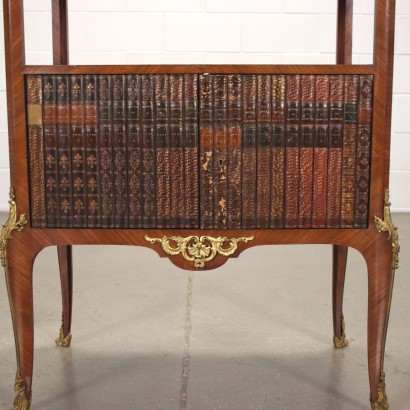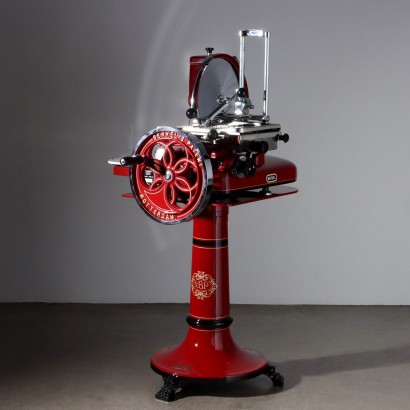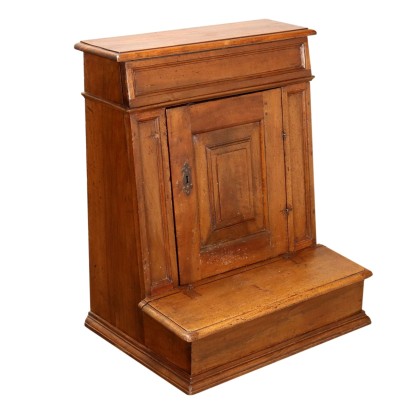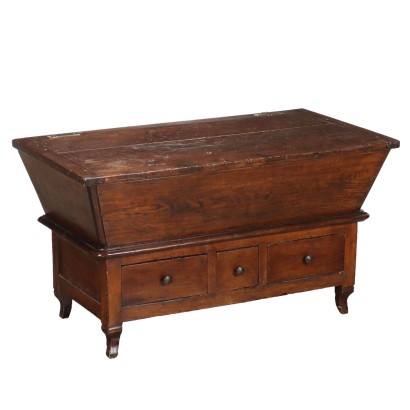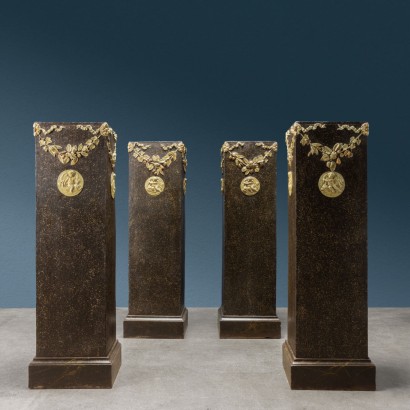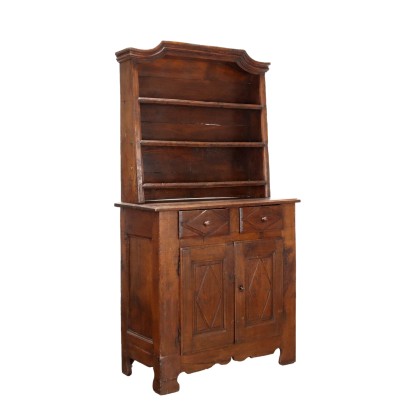Bookcase and Étagère Mahogany Bronze Napoleon III - France XIX Century
Features
Style: Napoleon III (1848-1870)
Age: 19th Century / 1801 - 1900
Origin: France
Main essence: Brazilian Rosewood , Mahogany
Material: Gilded Bronze
Description
French Napoleon III center bookcase, supported by wavy legs, the lower band on both the front and sides is shaped; on the front it has two doors finished with fake books, with applied leather ribs, so as to simulate an open bookcase. In the upper part there is an open compartment and an upper tray shelf. The etagere has a similar shape, but in the central compartment there are various shelves placed at different heights. Interior in mahogany, they are veneered in bois de rose, with a 45 ° cut and quadripartite on the tops; the furniture is decorated with gilded bronzes and worked with leafy volutes, in the shoes, on the uprights, on the lower band and in the side handles.
Product Condition:
Product that due to age and wear requires restoration and resumption of polishing.
Dimensions (cm):
Height: 85
Width: 65,5
Depth: 36,5
Certificate issued by: Enrico Sala, expert
Additional Information
Style: Napoleon III (1848-1870)
With Napoleon III as emperor, France experienced a period of extraordinary economic prosperity, a factor that allowed it to reconstitute a formidable war machine.In short, the dream that had once been Bonaparte's was revived: France as a great European hegemonic power.
The euphoria and grandeur also found perfect correspondence in the furnishings that characterized the Second Empire.
In Italy, the Napoleon III Style initially had insignificant effects, imposing furnishings in imitation of Louis XVI with an ornamental value resolved only in carving and completely devoid of bronze frills, in deference to a more sober taste that would always characterize Italian clients.
Only in the first decades of the twentieth century did "French" furniture find important commercial outlets in our country.
This is the name given to the artistic production of France under Napoleon III, president in 1848 and emperor from 1852 to 1870, the year of his abdication.
Rather than a style, we can speak of a set of styles, or rather revivals, given that in these years the eclectic tendency that had already appeared during the previous reign of Louis Philippe developed to its extreme consequences.
The drive to re-evaluate history and the Middle Ages also derives from the romantic spirit, as well as from the nationalistic one.
The houses were therefore furnished by mixing different styles and drawing from both the past and the East, with a tendency towards luxury and pomp that reflected the emperor's desire for grandeur.
In general, there was a return to the entire 18th century, with particular attention to Louis XVI; the fashion for dark woods (ebony and rosewood), exotic woods and bronze applications is confirmed.
From the 17th century onwards, the inlay created by André-Charles Boulle, the great cabinetmaker of Louis XIV, was revived. He created an inlay technique in gilded bronze and tortoiseshell, in which one of the two materials acts as a background for the perforated designs of the other.
Compared to the refinement of the original pieces, the "Boulle" furniture of this period is heavier and also flashier, given the addition of bright colours through painted sheets or parts in horn coloured blue, red or green.
Always in the wake of eclecticism, Venetian furniture arouses particular interest, which stimulates the production of polychrome and gilded furniture, in which figures of Moors often appear as supports.
These latter are also linked to the passion for the exotic that leads to the fashion for chinoiserie (in especially after the conquest of Beijing in 1860).
Discover more about the Napoleon III style with our insights:
a Napoleon III Secretaire to discover the cabinet with hiding places
A Napoleon III table to discover the caryatid
FineArt: Chandelier – O. Lelièvre & Susse Frères, Paris, last quarter of the 19th century
FineArt: Napoleon III Sideboard
The Austrian taste of Baroque
The Louis XV cabinet
The history of the writing desk
Napoleone III: the charm of the exotic in furniture
Age: 19th Century / 1801 - 1900
19th Century / 1801 - 1900Main essence:
Brazilian Rosewood
It is a hard, light blond wood, but with strong red and pinkish veins, which is obtained from tropical trees similar to rosewood. Its veins are reminiscent of striped tulips, which is why it is called tulipwood in English-speaking areas. It is used for inlays, often combined with bois de violette. In the 1700s and 1800s it was highly appreciated and used in France and England for precious veneers. It gives off scent for decades if not centuries after curing.Mahogany
It is one of the most precious and sought-after woods in cabinet making. It was discovered in Central America around 1600 and began to be imported to England in the 1700s. Much appreciated for its hardness and indestructibility, it became widespread following the blocking of walnut exports from France in 1720 and the consequent elimination of English import duties on mahogany from the colonies in America and India. The most valuable version comes from Cuba, but it became very expensive. At the end of the 18th century it began to be used also in France in Louis XVI, Directory and Empire furniture, its diffusion declined starting from when Napoleon, in 1810, forbade its import. It was generally used in the manufacture of elegant furniture, due to its characteristics and beautiful grain.Material: Gilded Bronze
Other customers have searched:
Se ti interessano i mobili d'antiquariato Scopri qui tutte le presentazioni dei prodotti d'antiquariato più belli, eleganti e preziosi su FineArt by Di Mano In Mano
Leggi di più
Sull'antiquariato in generale dai un'occhiata anche a:Antiquariato: una sezione per raccontare i mobili antichi che sono arrivati fino ai giorni nostri.
Classic Monday: da un pezzo dei nostri magazzini alla storia dell'antiquariato
L'antiquariato dalla A alla Z: il Dizionario dell'Antiquariato
Il dizionario dell'antiquariato - Lastronatura
Il dizionario dell'antiquariato - Mascherone
Il dizionario dell'antiquariato - Natura morta
Il dizionario dell'antiquariato - Opificio
Il dizionario dell'antiquariato - Pastiglia
Il dizionario dell'antiquariato - Savonarola
Il dizionario dell'antiquariato - Rosone
Intaglio barocco con motivo a ricciolo
Infine, dai un'occhiata alle nostre rubriche di divulgazione sulla storia delle arti decorative e d'arredo:
Epoche
Lavorazioni e tecniche
Mostre ed Eventi
Protagonisti
Product availability
The product can be seen at Cambiago
Immediate availability
Ready for delivery within 2 working days from ordering the product.




